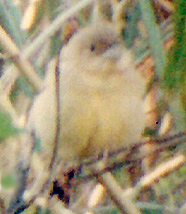Black-headed Bunting Emberiza melanocephalus
One, possibly adult female, November 4th 2000.

In light to moderate northwest winds on November 4th 2000 a large and heavy bunting flushed up out of tangled grasses onto overhead telegraph wires at the top of the road above 1-Gu on Gageo Island. It had yellow underparts, showed no white in the outertail feathers, and had a large grey bill. Consequently it could immediately be identified as either a Black-headed or Red-headed Bunting Emberiza bruniceps, both species previously observed by Nial Moores in Europe or Japan. The bird perched overhead for about 30 seconds, before calling an Ortolan-like "plett" and flying into denser cover. Over a two hour period it showed well for a total of 2-3 minutes, and could be confidently identified as a Black-headed, as (1) it looked obviously large for a bunting, with (2) a fairly massive-looking bill; (3) the head showed extensive and strong streaking on the crown; and (4) diagnostically dark grey tones to the ear coverts, contrasting withthe crown; (5) the rump and uppertail coverts, as well as (6) the back, were warmer brown (not yellow-green), but most of the upperparts appeared cold grey-brown, with weak dark tramlines on the back and mantle. (7) There was one clear white wing-bar (on the median coverts), and the remiges of the closed wing were broadly edged very pale yellow. (8) The underparts were extensively yellow and unstreaked, with the strongest colour towards the vent. Photographs were taken with a hand-held camera through the telescope, and though the resultant images are extremely poor, they reveal the key features for identification as Black-headed Bunting.
The Black-headed Bunting breeds in southeast Europe east into regions south of the Caspian Sea and winters mainly in western and central India (Byers, Olsson and Curson, 1995). According to the same authors the species "seems to have a propensity for overshooting mainly in spring", but even more surprisingly it appears to have become a near regular vagrant to Japan (with eight published records between 1985 and 1990, most in late autumn or early winter: Brazil 1991), and other countries, with records even coming from as far southeast as Indonesia. With such a tendency to wander, the Black-headed Bunting will surely be recorded in Korea more often once identification criteria become better-known.
Update:
A male Black-headed Bunting was found on Eocheong Island in May 2003. For more details go to Black-headed Bunting - second record for Korea.



